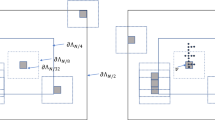Abstract
We consider the zero-temperature single-spin-flip dynamics of the random-field Ising model on a Bethe lattice in the presence of an external field h. We derive the exact self-consistent equations to determine the distribution Prob(s) of avalanche sizes s as the external field increases from −∞ to ∞. We solve these equations explicitly for a rectangular distribution of the random fields for a linear chain and the Bethe lattice of coordination number z=3, and show that in these cases, Prob(s) decreases exponentially with s for large s for all h on the hysteresis loop. We find that for z≥4 and for small disorder, the magnetization shows a first-order discontinuity for several continuous and unimodal distributions of the random fields. The avalanche distribution Prob(s) varies as s −3/2 for large s near the discontinuity.
Similar content being viewed by others
REFERENCES
J. P. Sethna, K. A. Dahmen, S. Kartha, J. A. Krumhans, B. W. Roberts, and J. D. Shore, Phys. Rev. Lett. 70:3347 (1993).
O. Perkovic, K. A. Dahmen, and J. P. Sethna, Phys. Rev. Lett. 75:4528 (1995).
Y. Imry and S. K. Ma, Phys. Rev. Lett. 35:1399 (1975).
J. Z. Imbrie, Phys. Rev. Lett. 53:1747 (1984).
T. Natterman, Spin Glasses and Random Fields, A. P. Young, ed. (World Scientific, 1998), pp 277_298; preprint cond-mat/9705295 (1997) and reference cited therein.
R. Bruinsma, Phys. Rev. B 30:287 (1984). See also P. M. Bleher, J. Ruiz, and V. A. Zagrebnov, J. Stat. Phys. 93:33 (1998) and references therein.
L. B. Sipahi, J. Appl. Phys. 75:6978 (1994) and references therein.
J. C. McClure, Jr. and K. Schröder, CRC Crit. Rev. Solid State Sci. 6:45 (1976).
K. P. O'Brien and M. B. Weissman, Phys. Rev. E 50:3446 (1994), and references therein; K. P. O'Brien and M. B. Weissman, Phys. Rev. A 46:R4475 (1992); U. Lieneweg and W. Grosse-Nobis, Intern. J. Magnetism 3:11 (1972); D. Spasojević, S. Miloš ević, and H. E. Stanley, Phys. Rev. E 54:2531 (1996).
J. S. Urbach, R. C. Madison, and J. T. Markert, Phys. Rev. Lett. 75:276 (1995).
P. J. Cote and L. V. Meisel, Phys. Rev. Lett. 67:1334 (1991); L. V. Meisel and P. J. Cote, Phys. Rev. B 46:10822 (1992).
L. Carrillo and J. Ordin, Phys. Rev. B 56:11508 (1997).
B. Tadić, Phys. Rev. Lett. 77:3843 (1996).
B. Derrida, J. Vannimenus, and Y. Pomeau, J. Phys. C 11:4749 (1978); M. Puma and J. F. Fermandez, Phys. Rev. B 18:1391 (1978); A. Vilenkin, Phys. Rev. B 18:(1474); S. Katsura and N. Miyamoto, Physica A 112:393 (1982).
D. Sherrington and S. Kirkpatrick, Phys. Rev. Lett. 35:1792 (1975).
K. M. Y. Wong, D. Sherrington, P. Mottishaw, R. Dewar, and C. de Dominicus, J. Phys. A: Math. Gen. 21:L99 (1988); E. Akagi, M. Seino, and S. Katsura, Physica A 178:406 (1991) and references cited therein.
B. Derrida, Phys. Rev. Lett. 45:79 (1980); Phys. Rev. B 24:2613 (1981).
A. Georges, G. Kotliar, W. Krauth, and M. Rozenberg, Rev. Mod. Phys. 68:13 (1996).
D. Dhar, P. Shukla, and J. P. Sethna, J. Phys. A: Math. Gen. 30:5259_5267 (1997).
This step is not really necessary if we are only interested in determining the magnetization at the site O. Skipping this step leads to considerable simplification of the relaxation process: first the spins of generation n are examined, then those of (n&1) etc. till we finally examine the spin at O. No spin is checked more than once. The resulting configuration is not fully relaxed, but it is easy to prove that further relaxation will not change the state of the spin at O. The argument can be extended to show that the probability that an avalanches starting at O is of size s also is the same in this partially relaxed state as in the fully relaxed state.
D. Stauffer and A. Aharony, Introduction to Percolation Theory (Taylor and Francis, London, 1992), pp. 26_34.
N. S. Ananikyan, N. Sh. Izmailyan, and R. R. Shcherbakov, JETP Lett. 59:71 (1994); Pis'ma Zh. Eksp. Fiz. 59:71 (1994).
Below Tc, the magnetization goes as m∼sign(h)[m0+A h (d-2)_2], as h→0 See G. Parisi, Statistical Field Theory (Addison-Wesley, 1988), p. 195. 128 Sabhapandit et al.
F. Pá zmá ndi, G. Zará nd, and G. T. Zemá nyi, preprint cond-mat/9902156 (1999).
This would happen if P*(h) as a function of h shows a ``double s'' curve. Then there must be at least 4 values of h for which the slope of the curve is infinite. This is possible only if the equation determining P*disc (variant of Eq. (29)) is at least a quartic, hence only if z≥6. 129 Random-Field Ising Model
Author information
Authors and Affiliations
Rights and permissions
About this article
Cite this article
Sabhapandit, S., Shukla, P. & Dhar, D. Distribution of Avalanche Sizes in the Hysteretic Response of the Random-Field Ising Model on a Bethe Lattice at Zero Temperature. Journal of Statistical Physics 98, 103–129 (2000). https://doi.org/10.1023/A:1018622805347
Issue Date:
DOI: https://doi.org/10.1023/A:1018622805347




